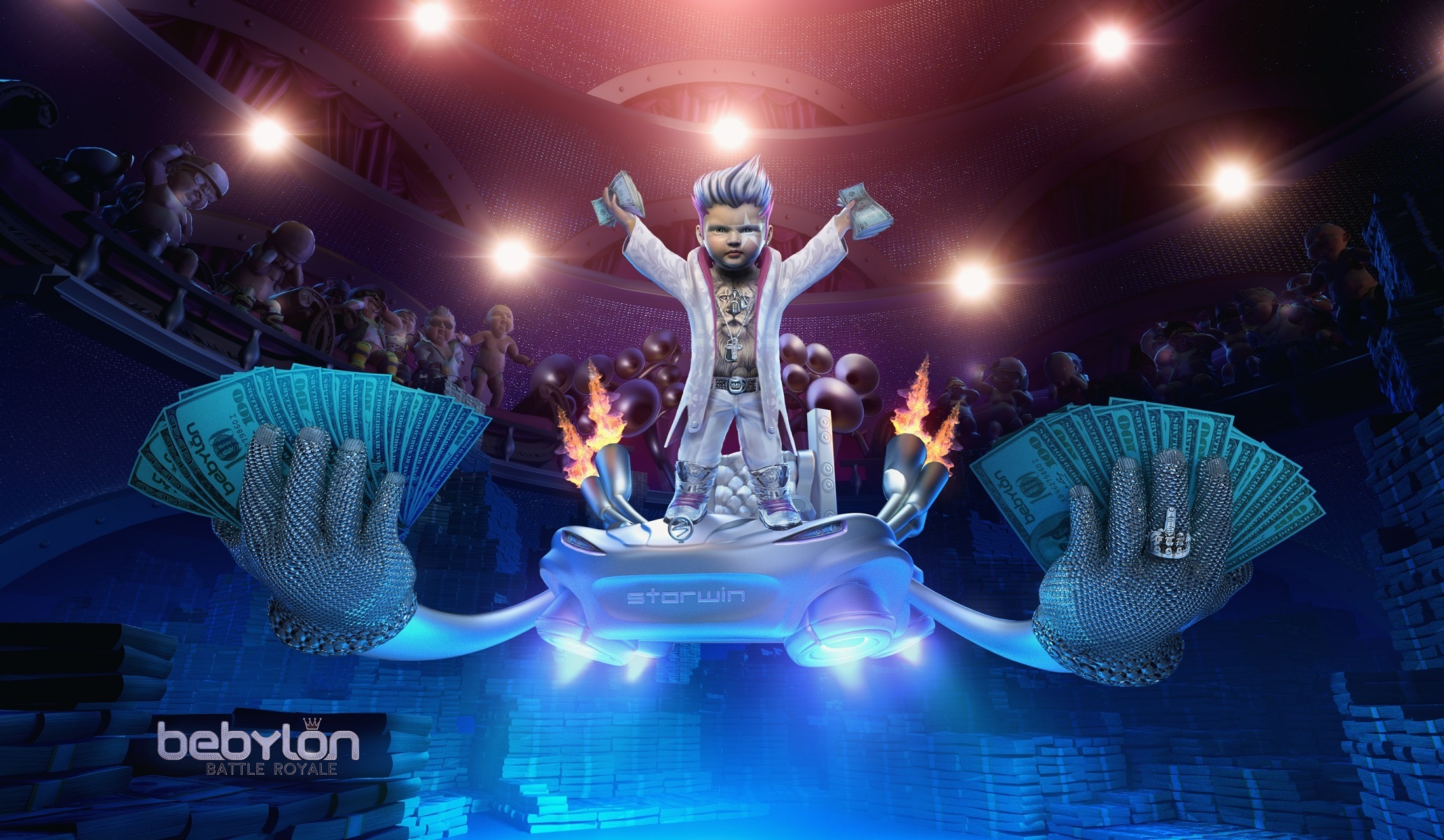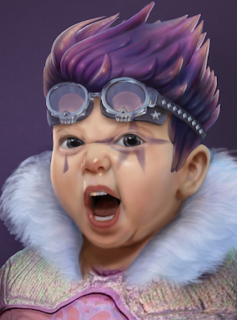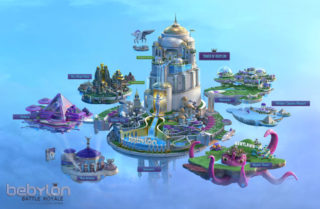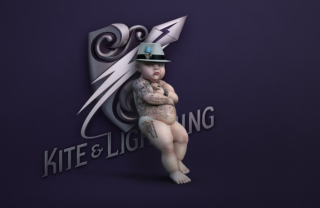If you have an insatiable appetite for nutty and narcissistic babies who seemingly stepped off the set of Mad Max to brawl in colosseums, consider yourself blessed because Bebylon Battle Royale is one step closer to becoming a reality—in virtual reality.
Cinematic VR studio Kite & Lightning’s radical, comedic social game has secured $2.5 million in seed funding led by Raine Ventures to bring the experience of immortal baby gladiators competing against one another in front of a live VR spectator audience for status and fame; players will be able to venture outside of the mishap future setting to socialize, experience shows and take virtual rides in what will be the Los Angeles-based studio’s first immersive gaming experience.
The brainchildren behind Bebylon Battle Royale are founders Ikrima Elhassan and Cory Strassburger, veterans in VR whose credits include VR experiences for brands such as Lionsgate (Insurgent), NBC Universal (The Voice) and GE (Neuro).
“Kite & Lightning has been pushing the envelope in cinematic virtual reality for three years, and we are thrilled to be partnered with this industry-leading creative team,” said Gordon Rubenstein, managing partner at Raine Ventures. “Their upcoming title, Bebylon Battle Royale, is the most impressive social gaming experience we’ve ever seen, and we believe is only the beginning of a unique metaverse that will captivate gamers and audiences for years to come.”
Ikrima Elhassan, co-founder and CEO of Kite & Lightning, joined [a]listdaily to talk about how they plan on blending gaming, social and story to create an emotionally transformative experience.

The $2.5 million in seed funding you received will surely grow your two-person team. How do you plan on further building out capability?
We’re looking forward to expanding the team size. We’ve already expanded to four and are still looking to hire multidisciplinary, passionate people who are looking to work in VR.
The origin of your story is a unique one. Why was it important to come back to the US after a year abroad? How is VR different outside of stateside confines?
Los Angeles is the epicenter of VR, even more so than Silicon Valley. We left for a year abroad for a creative sabbatical and to focus on laying the groundwork for the Bebylon universe. Outside of the US, VR is definitely more nascent but attracts a small group of super-dedicated people. I think the VR scene in Paris is making the best headway in VR cinema. We always intended to return after a year, but it’s great to interact with folks outside the US in VR.

What does operating a hybrid film and gaming studio allow you to do when it comes to combining cinematic storytelling with interactive gaming?
I think this is just our focus on what we think make compelling VR experiences. We say what theater was to film, VR is to film. Just like theater still exists in modern-day society, completely passive VR experiences will exist in the future. But, the most compelling experiences will be a meld of interactive/gaming and narrative.
Can you explain your pillars of gaming, social and story, and how it all comes together? Why is this combo critical for a great VR experience?
Our world is set in a future where humanity discovers an immortality pill; the downside is that no one ages past the baby stage despite being mature adults on the inside. At the core of this world is the Super Smash Bros.-esque style game where baby gladiators compete against each other for status and fame. So as a player, you can be a gamer and partake in these arenas and try to become the most famous, narcissistic baby gladiator. But, you can also go attend and spectate the matches as all of the stages occur in colosseum-style arenas. As a spectator, you can also cheer, boo or even toss items into the ring that players can use in their fight. And then outside of the arenas, there exists the entire mini-MMO universe of Bebylon Battle Royale where you can experience the history of Bebylon as well as attend shows, go on rides and socialize with other players. So, we like to say, ‘come for the game, stay for the social narrative.’
How can gaming experiences, specifically ones that are social, turn from a one-to-one to a social one?
For us, it’s been designed as an integral part from day one. ‘Let’s play’ is already a huge phenomenon in gaming with Twitch and YouTube and we feel that it’ll be more important in VR. With Bebylon, we wanted to take ‘let’s play’ one step further by allowing interactive spectating where you can also affect the outcome of the matches by throwing items and sponsoring different gladiators.

Bebylon Battle Royale is a world built around competitive spectator gaming. Can you tell us a little more about how the idea sparked, what the VR experience will entail, and how it differentiates itself?
The idea sparked from an insight we had years ago. During the course of creating VR experiences for the last three years, we knew that some of the most compelling moments in VR was when we combined interactive elements from gaming while transporting you to surreal environments. And then from there, we immediately wanted to have our friends there with us. But when we had the original groundwork for this idea years ago, it was way too ahead of its time and the VR ecosystem was too small. Now we have the resources as well as an eager, rapidly growing audience to bring this to life.
What have you learned along the way about creating engaging VR experiences? What’s your special sauce?
I’d say keeping an open mind and constantly experimenting is the secret to creating engaging VR. The medium is so new that there are no experts, and for every best practice that someone spouts, there’s a great counter example.
What is the best way brands can use 360-degree video and VR for their integrated marketing strategies?
I don’t think 360-degree video is a good way for brands to utilize VR in their marketing strategies. I think 360-video is a small ephemeral stepping stone that will quickly go away. I think people gravitate toward it because it’s the lowest common denominator and requires the lowest technical barrier to entry, but I don’t think the best compelling VR experiences come from 360 VR. The Martian is a great example of what I think is a great integrated brand marketing strategy.

What is the hardest part about marketing VR?
It’s really difficult to convey how awesome something is in VR when you only see a trailer of it in a 2D version. Some people have done some cool innovations with mixed reality videos but at the end of the day, if you’ve never tried VR, you’re just not going to understand. Trying to convey VR to someone is like trying to convey how awesome your favorite song is through pictures.
Are consumers ready for VR today? Do you think they are clamoring for it? Or are they coiled?
Absolutely; we’re constantly surprised by how fast the VR audience is growing and how everyone we’ve ever shown VR to wants to buy a headset. We still think it’ll be two years before VR goes wide mainstream, but it definitely will.
Follow Manouk Akopyan on Twitter @Manouk_Akopyan

